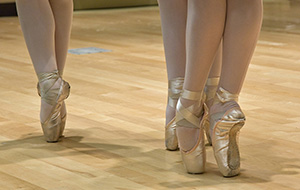 The aesthetics of ballet are continuing to evolve, however something which has remained a constant is the appearance of the foot when it is fully pointed. The ankle joint has limited movement outwards and inwards, however the adjustments of the foot’s position can make a big difference to how it looks to the audience.
The aesthetics of ballet are continuing to evolve, however something which has remained a constant is the appearance of the foot when it is fully pointed. The ankle joint has limited movement outwards and inwards, however the adjustments of the foot’s position can make a big difference to how it looks to the audience.
The foot as an extension of the ankle can elongate an arabesque or alternatively turn it inwards and demonstrate a weaker foot by sickling. When the foot is pointed in a neutral position an invisible line can be traced up through the floor, foot and into the ankle. Whilst this is technically correct, a winged shape can be seen as more desirable in that the toes are pointed outwards, extending the line. Sickling the foot might indicate poor training or weakness in the ankle, as well as demonstrating a more unsightly line.
The ankle has a slightly larger range of motion inwards, so students may be prone to sickling regardless. Genetics or anatomy can also contribute to a student’s tendency to sickle, and injuries can occur when the foot is both sickled and weight-bearing. This pulls the tendons of the ankle out of alignment, yet injury can occur when winging the foot too. Sickling can even be the intention for some choreographers, if that is what the movement or piece demands, yet for the majority of times, improving ankle strength and stability will minimise sickling.
If the foot winging is supporting weight, this too pulls the ankle joint out of alignment. Dancers may force their heels forward with tendus, instead of using their turnout. This places stress on the tendons on the inside of the foot and twists the knee joints. Despite this, winging could be encouraged in non-weight bearing positions in order to improve individual aesthetics and enhance the line – and limited turn out – the dancer is creating. Turn out must be fully engaged however, so as not to solely rely on the shape of the foot.
